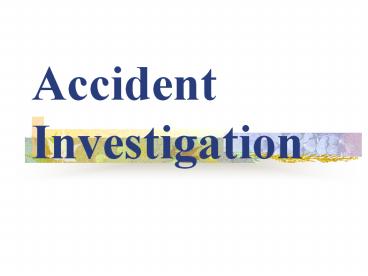Accident Investigation - PowerPoint PPT Presentation
1 / 17
Title:
Accident Investigation
Description:
Accident Investigation Objectives Explain the meaning and impact of accidents Identify different types of accident causes Know the purpose of accident investigation ... – PowerPoint PPT presentation
Number of Views:986
Avg rating:3.0/5.0
Title: Accident Investigation
1
Accident Investigation
2
Objectives
- Explain the meaning and impact of accidents
- Identify different types of accident causes
- Know the purpose of accident investigation
- Explain how to conduct an accident investigation
- Know how to document accident investigations.
3
What is an Accident?
- Unplanned event results in mishap (personal
injury or property damage). - Accidents are the result of the failure of
people, equipment, materials, or environment to
react as expected. - All accidents have consequences or outcomes.
4
Purpose of Accident Investigation
- Determine the sequences of events leading to
failure. - Identify the cause of the accident.
- Find methods to prevent accident from recurring.
5
Consequences of Accidents
- Direct Consequences
- Personal injury
- Property loss
- Indirect Consequences
- Lost income
- Medical expenses
- Time to retrain another person
- Decreased employee moral
6
Types of Causes
Basic Causes Poor Management Safety Policy
Decisions Personal Factors/Environmental Factors
ACCIDENT Personal Injury Property Damage
Conditions
Unsafe Act Performance
Indirect Causes
Unplanned release of energy (Direct Cause)
7
Examples of Accident Causes
Direct Causes Indirect Causes Basic Causes
Struck by/against Failure to secure No oversight
Falls Guarding Poor maintenance.
Caught in/between Improper use Training
Exertion Unsafe position Policies
Contact with. Environmental Stress
Impact (vehicle) Defect Engineering
8
Be Prepared
- Develop a policy for accident investigation
- Routinely audit your policy to
- - ensure personnel understand their role
- - system is driving corrective actions
- Assign responsibilities to personnel
- - employee must be trained to investigate
- - investigator should know process
9
Conducting the Investigation
- Interview witnesses.
- Document the accident scene before any changes
are made. - Review all information (procedures, equipment
manuals).
10
Conducting the Investigation
- Make documented observations on
- Pre-accident conditions
- Accident sequence
- Post-accident conditions
- Document the facts (i.e. location, witness
remarks, and contributing factors). - Determine sequence of events leading to accident
11
Common Problem Solving Methods
- Job Hazard analysis
- Sequence diagrams
- Change analysis
12
Job Hazard Analysis
Steps Hazards Causes Control Measures
13
Change Analysis
- A change analysis consists of
- Defining the problem
- Establishing the norm
- Identifying, locating, and describing the change
- Identify what was affected and not affected
- List features of change
- Pick likely causes
14
Witness Interviews
- Interview promptly.
- Establish rapport with witness (treat as equal).
- Get the facts.
- Write down the witnesss statement
15
Documentation
- Complete an accident investigation form to
collect - Personnel information
- Accident information (location, events leading to
accident, machines involved) - Causes of the accident
- Recommendation to prevent accident
- Follow up information
16
Documentation
- From the accident investigation form and witness
statements write an accident investigation
report. The report should include - Background information (where, who)
- Summary (sequence, extent, type, source)
- Analysis (causes)
- Recommendations
17
Steps to Accident Investigation
- Survey the scene
- Secure the scene (initiate interim controls)
- Get help for the injured
- Collect evidence
- Analyze data
- Determine causes (scientific methods)
- Follow up (eliminate hazards)































